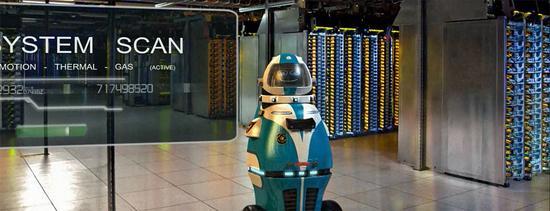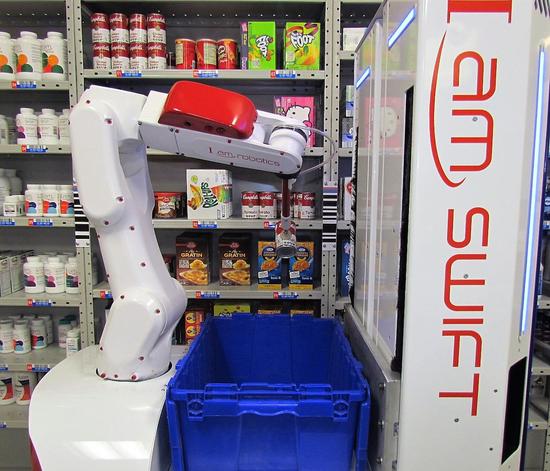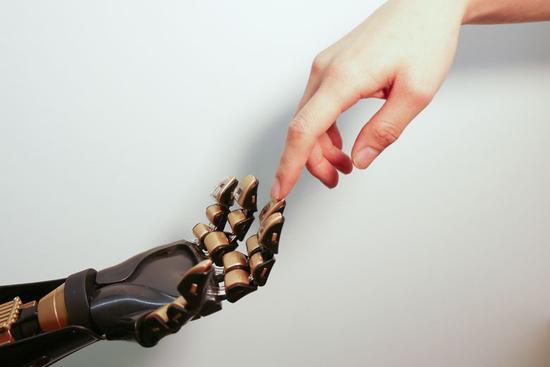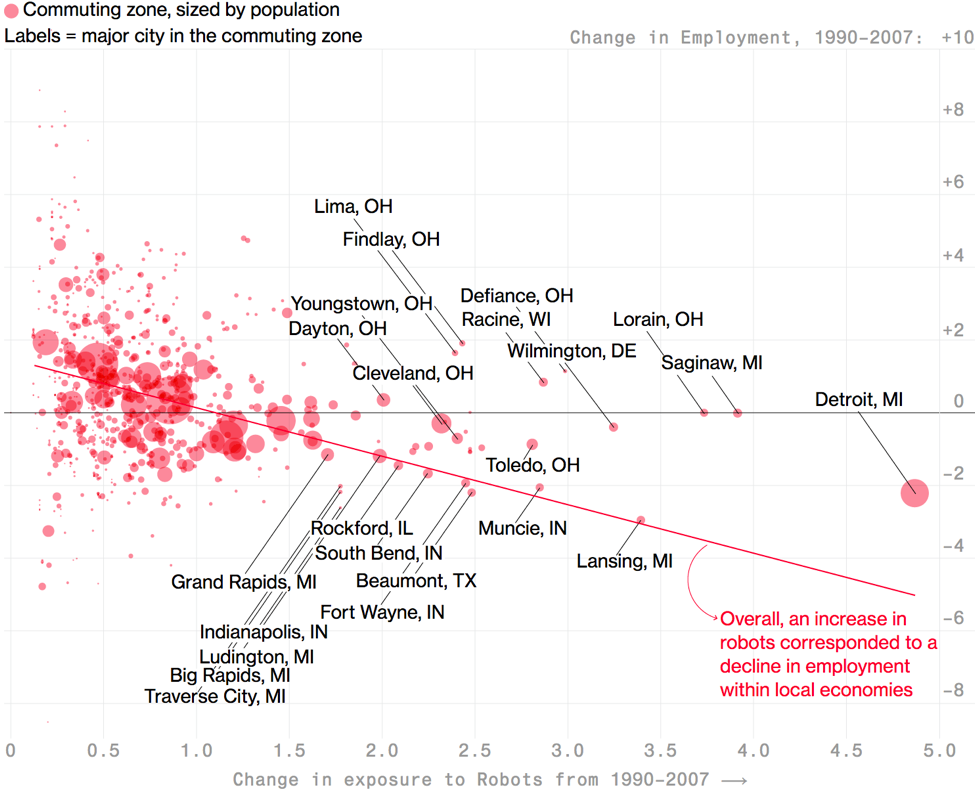(Original title: How are smarter industrial robots changing our lives?)
Ding Shibei
Abstract: The recent AI wave and cheaper and cheaper robots are constantly upgrading. They are starting from manufacturing, warehousing, etc., to transform the entire industry.

Picture from American Security Today
"Don't push me. When you push me again, I'll ring the alarm."
Ramsee is a new security robot from American company Gamma2 Robotics. If you push it hard, it will give this kind of "goodwill reminder."
The deeds of this robot are:
After the female reporter asked it, "Ramsee, can you play with some tricks to see it?" After that, it was frightened by the flashes and wolves and shouted and thundered and gave off a loud bark, allowing for the consumption of onlookers. FleeingOf course, its procedural settings make it impossible to harm humans, and these reactions are completely different from its working state, but because of its AI component, consumers and the media have more reasons to contact with it and opportunity.
In fact, its greatest usefulness is to conduct 24-hour patrols at semiconductor factories, shipyards, warehouses, military facilities, and other places to detect possible gas leaks, fires, floods, etc. in a timely manner, and walk on the edge of danger.
As early as several decades ago, early robots had already appeared. However, the recent wave of AI and increasingly cheaper costs have caused robots to constantly upgrade. They are starting from manufacturing, warehousing, etc., to transform the entire industry.
Robot Evolution: AI, Data, and Artificial Skin
With AI blessings, nowadays industrial robots are smarter.
Taking Iwi Robotics' storage robot Swift as an example, at a glance, it's no different from the old robots that used suction cups to grab items. At best, the latter is faster.

Swift robot, picture from I am Robotics
Behind the awkward Swift, it is actually from DARPA (advanced project research bureau of the U.S. Department of Defense) and very advanced computer vision technology—it is not hard-coded to be instructed to “take the seventh to the second row of fifth shelf†"Things", but through computer vision technology "recognize" what they want to take, and then dexterously and quickly grasp.
Tom Galluzzo, the founder of I am Robotics, told the titanium media that Swift is the only robot on the market that can be moved quickly and can be accurately grasped. It can completely replace humans for sorting. “A robot can save Millions of dollars in labor costs."
Another example is Ramsee, who is also doing security. The human security guard may have to see the real body of a suspicious person in front of the camera. After a round of patrols, Ramsee can find out through comparison and analysis that “What? How did the chair move? "Centimeter?", and then send a signal to the background, so that employees of the control center can find intruders in time.
And for enterprise-level security, it is much more important than accident prevention to prevent gas leaks and fire accidents. Ramsee can detect smoke, explosive gas, humidity, carbon dioxide and other dangerous sources, will not be tired, will not omit, and the reaction is very fast, but also reduce the cost of security by 45%, is obviously a better choice.
In addition, the application of robots in the industry also means another thing: they can do mobile information collection and interaction.
In the past, robots finished their work and it was difficult to save large amounts of data locally. Both Swift and Ramsee can use different sensors to record data, upload clouds in real time and analyze them.
In the e-commerce industry where Swift can be widely used, the demand for logistics and warehousing will only increase. Recording and analyzing the shipping data of goods will be a big pain point. These accurate, large amounts of real-time data are also likely to provide greater business value in the reverse direction.
"The world will become more flat, and everything may be sold through distribution points, so improving the efficiency of logistics and warehousing in the future is very important, and machine-making is basically an irreversible trend." I am Robotics and investment in Gamma2 Robotics Zhang Jian, a founding partner of the Silicon Valley Fusion Fund, told the titanium media.
In the future, robots are likely to be further upgraded in multiple dimensions.
One of Zhang Jian’s partners, the academician of the American Academy of Engineering, and Professor Bao Zhenan of Stanford University invented the artificial skin as one of them. This is an invention of “Time Magazineâ€. Placed on the robot's body or arm, you can perceive temperature and pressure changes like humans, and if you have a small wound, you can also heal yourself. "Maybe it will be a new type of material that robots will apply to in the future."

Picture from stanford.edu
Will robots take away our work?
In a sense, this answer is almost certain. The machine is not afraid of danger and can easily replace human staff who are prone to making mistakes, fatigue, and high labor costs. It is almost an inevitable choice to increase production efficiency.
According to the analysis provided by PricewaterhouseCoopers, the most easily replaced types of jobs are found in the transportation and storage industries, manufacturing, wholesale, and retail industries, with risk probabilities of 56%, 46%, and 44%, respectively.
But there are other aspects of this matter.
1. Some positions have disappeared, and others may appear.
The Boston Consulting Group had previously conducted a survey of industrial automation in Germany and found that intelligence and automation would squeeze out about 610,000 factory jobs.
However, at the same time, it will also add 960,000 new jobs.
For example, in the security industry that used to require more than a dozen people to shift to work, although the patrols were carried out by robots, human employees are still needed. "The staff needs to monitor real-time images sent back by various robots in the control room and proceed to the next step based on the data they return and the results of the analysis. The robot cannot make a 'dial 911' or 'call fire truck' by itself. Acts.†Brian Johnson, founder of Gamma2 Robotics, told the titanium media.
2. Without a robot, your work may not be guaranteed...
In March of this year, MIT professor Daron Acemoglu and Boston University professor Pascual Restrepo jointly published their findings. From the figure below, it can be seen that the application of more machines is indeed related to the reduction of positions.

Image credit: Daron Acemoglu of Massachusetts Institute of Technology and Pascual Restrepo of Boston University
However, it should be noted that in industries where the proportion of machine automation is very low, many people are losing their jobs, such as the textile industry, paper products industry, and so on. These industries can not keep up with the trend of automation, high production costs, facing the dilemma of the loss of users, the industry practitioners even resist the robot, there is no way to keep the job.
3. The robot may increase your salary.
As mentioned above, some industries face difficulties because of their low level of automation, and some industries’ productivity is greatly increased due to automation, which greatly exceeds the rate of increase in employment rates.
"Overall, industrial robots are much more than a replacement for workers on the assembly line - it can effectively increase individual work efficiency and productivity, thereby creating more value for the entire industry, which is also beneficial to human society. "Zhang Jian said.
In 2015, a report released by BCG pointed out that the wider use of robots can effectively increase production efficiency by about 30%, while higher productivity helps increase the salaries of human employees.
Save small industrialists and break monopoly?
For the average person, the worries of the robot are very real: It will not make it difficult for me to find a job, and may be a threat to my life.
But robots that are simpler to operate and lower in price are also life-saving straws for some small industrialists.
PTG SIlicones CEO Brando Cahill said in an interview with Bloomberg: “I’ll be in the morning at 7:30 in the morning with my hands clasped together and looking out the window, hoping we hire these machine operators to come to work.†The modelling machine in his factory Working at temperatures up to 350 degrees Fahrenheit (about 175 degrees Celsius) is a very dangerous job. After he chose to purchase robots from Swiss robot company Staubli Corp. to handle this work, everything was solved.
During an interview with Bloomberg, he had already placed an order for his sixth robot.
In recent years, in the security, hotel, warehousing and other industries, there is also a shortage of human resources. “The e-commerce industry is accelerating every year, but people are now more willing to be Uber drivers than warehouse pickers.†Tom told reporters at Titanium Media.
At the same time, robots have other social meanings.
"Technology is actually breaking the monopoly and the class, breaking the unfair advantage between regions, and improving efficiency anywhere," Zhang said.
In the past, more expensive robots were used in a limited number of industries, such as manufacturing and IT industries. The use of most of the world's robots is also limited to a number of production and export countries, including China, the United States and so on. The "popularization" of robots may be a good thing for companies and regions with insufficient strength.
The following is a brief Q&A by Titanium media reporter and early investors of I am Robotics and Gamma2 Robotics and famous Silicon Valley investor Zhang Jian:
Titanium Media: Why did you choose to invest in these two robotics companies? What are the differences between them and other companies on the market?
Zhang Hao: They actually have these common characteristics: First, they are in line with the actual needs of the industry, and they have all found a good market entry point for the commercialization of robots.
Secondly, the power of data and AI technology are well utilized. Data collection can be done more efficiently and quickly through modular sensors assembled by industrial robots; based on these data, more business value will be brought in the future, especially In terms of improving industrial efficiency. Hardware sensors are the entrance for data collection. Real-time data analysis and interaction through the cloud may provide more business opportunities in the reverse direction.
Third, the cost is controllable, and the productivity of a single robot is high.
Titanium Media: After combining these new technologies and robots, which industries do you think will be accepted first? why?
Zhang Wei: The earliest entry point I think will be the industry and the medical industry. Because in these two industries, the commercial value of industrial robots is very clear, and now there are suitable application scenarios. At this stage, the cost of industrial robots is also acceptable and creates a huge profit margin, while helping the industry further reduce production. Cost, these two companies are actually the corresponding examples.
In the medical field, surgical robots and rehabilitation robots are gradually entering the market. Robots used in medical applications also serve as an “extension†to connect patients with pharmaceutical companies or hospitals to help them better postoperative recovery.
If you are moving toward the consumer, you may need to wait and see for some time. At least our fund's current investment in robotics is mainly focused on industrial and medical applications. To C may have to wait for three things: a further reduction in costs, whether there is a suitable application scenario, and how much the user is mentally accepting home robots.
Titanium Media: Can you talk about your view of the machine replacing people?
Zhang Hao: More dexterous robots will definitely make some industries and jobs disappear, but this does not mean that there will be large-scale unemployment. The application of technology is gradual, there will be a buffer time, so that everyone can adapt to this trend; also like before talking about, the new technology, of course, also means that the individual's productivity enhancement and the emergence of new job opportunities.
Compared to worrying about machines replacing people, I prefer to be optimistic. In the next few years, technology will continue to develop in the direction of further strengthening of the human mind from the mental and physical levels. The combination of machine and human body may be another It is worth discussing. (This article starts with Titanium Media, Reporter/Ding Shibei)
Brake Disc For MITSUBISHI
Mitsubishi Brake Disc,Mitsubishi Auto Brake Disc,Mitsubishi Car Brake Disc,Mitsubishi Automobile Brake Disc
Zhoushan Shenying Filter Manufacture Co., Ltd. , https://www.renkenfilter.com